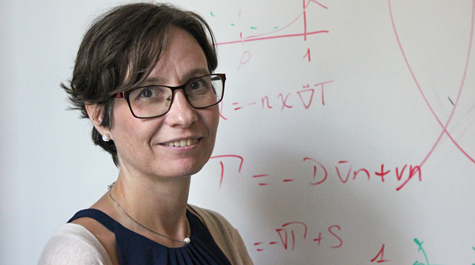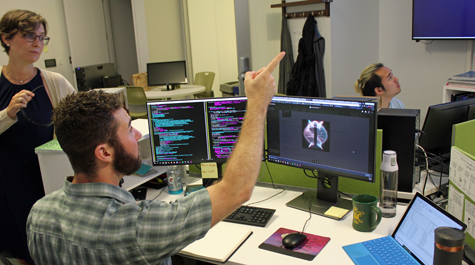Mordijck to lead U.S. Department of Energy milestone initiative
Each fiscal year, the U.S. Department of Energy’s Office of Science sets a milestone to achieve in the field of fusion research – and this coming year a William & Mary professor will be at the helm. Their plan is to learn how to fuel an artificial sun.
Starting Oct. 1, the new DOE initiative will be led by Saskia Mordijck, assistant professor of applied science at William & Mary. Mordijck will serve as the global leader of the Joint Research Target for the Office of Fusion Energy Sciences, working with labs throughout the world to solve the complicated problem of refueling fusion reactions, like those that power the sun.
“This is actually fairly new, in the sense that this is the first time they are starting to include academia in these milestones,” Mordijck said. “I will be the first faculty member to lead this endeavor. On top of that, as far as I can tell, I will be the first female leader, which is a big thing for our field.”
{{youtube:medium|IND6_1Cmdq4, Exploring fusion: A path to power a sun}}
Mordijck has spent her entire career working in fusion research and specializes in the physics of fueling fusion reactions. She was recently awarded $1 million for a fusion research partnership between the DOE and William & Mary.
The Office of Fusion Energy Sciences describes its overall mission as building “the scientific foundation needed to develop fusion as a future energy source.” Mordijck says that horizon is getting closer every year, but time is running out.
“Ignoring the consequences of climate change, those of us living today will probably get by on fossil fuels, but our children, grandchildren, they’ll run out of fossil fuels eventually down the line,” she said. “It never hurts to have a diverse energy economy. And with fusion power, you are talking about one gram of seawater to fuel a city.”
The concept of fusion is relatively easy to explain, but incredibly challenging to achieve, Mordijck says.
“Fusion is something very simple in one sense. It’s what we see every day. It’s the sun,” she said. “It’s a simple principle that works very reliably, but it’s much more difficult to accomplish here on Earth.”
To accomplish fusion, two small particles are heated to a high enough temperature that they fuse together. In fusing, some of their mass is released and converted into energy. If done correctly, the resulting energy will be greater than the energy required to fuse the two particles together. It’s essentially the opposite of fission, the method of breaking apart atoms that fuels nuclear power plants and atomic bombs. One method forces particles together, the other splits them apart.
Within the sun, the fusion of hydrogen nuclei into helium has produced enough energy to warm Earth for billions of years – but the sun’s density plays a key role in those fusion reactions, Mordijck explained. On Earth, creating that much density would be not only impractical, but dangerous if the scale was large enough, she added. That means that in order to create a fusion reaction on Earth, the environment has to be even hotter than the sun.
“When you are heating a gas up to those kinds of temperatures, it becomes a plasma,” Mordijck said. Plasma, the fourth state of matter, interacts with its surroundings in ways that are still not fully understood by science. But at least one thing is clear, plasmas can be contained by magnetic fields, like those generated by tokamak devices in the U.S. and abroad. Mordijck and her graduate students, Ryan Chaban and Richard Reksoatmodjo, regularly collaborate with scientists running the tokamak at the DIII-D National Fusion Facility in San Diego.
“We have to use very strong magnetic fields to confine our plasmas,” Mordijck said. The issue, she explained, is that after a contained fusion reaction begins, it’s hard to keep it going. “While the sun has about four or five billion years of fuel, a fusion reactor on Earth cannot have that much fuel in it, so we will have to fuel it constantly to counter for plasma leaking out.”
Chaban and Reksoatmodjo will be working with Mordijck over this next year to further our understanding of how to fuel fusion reactions. Their research will be an integral part of the DOE’s Joint Research Target for 2019. Mordijck says she’s looking forward to the challenges that come with managing a global milestone project and hopes to set an example for female fusion scientists.
“It’s important for women in our field to take on leadership positions,” Mordijck said. “We’re showing the next generation that these are opportunities, these are possibilities and we’re just as capable as our male colleagues to step into those roles when we are called to do so.”
 Skip to main content
Skip to main content



